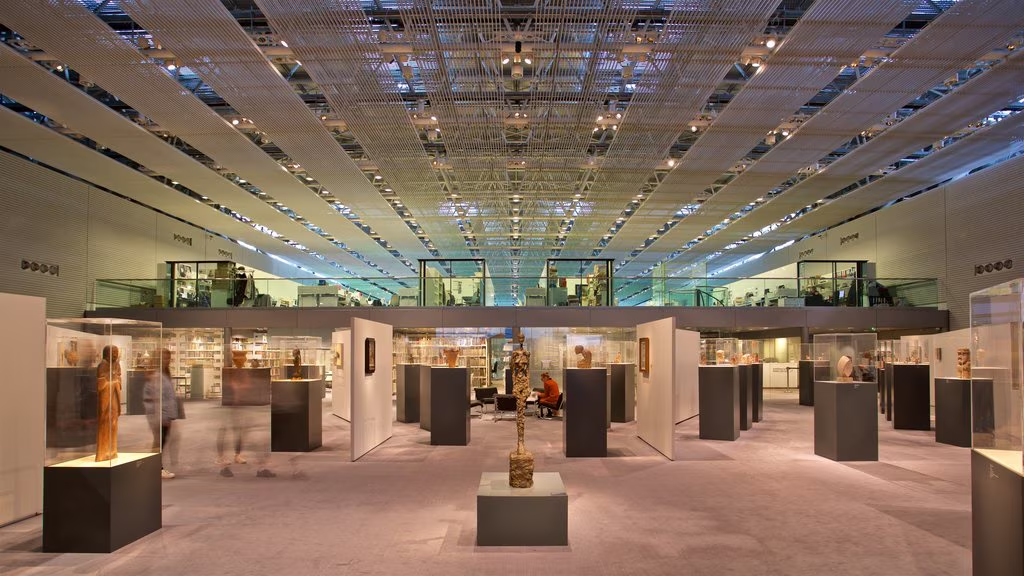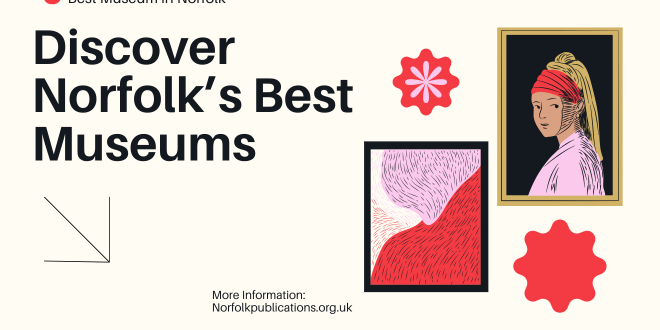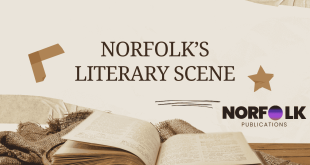Norfolk is renowned for its stunning landscapes, rich history, and vibrant culture. With a legacy stretching back thousands of years, it’s no surprise that the county boasts some of the UK’s most fascinating museums. From ancient artifacts and medieval treasures to contemporary art and maritime history, Norfolk’s museums offer something for every visitor. Whether you are a history enthusiast, an art lover, or simply looking for a family day out, the museums in Norfolk provide an enriching experience that reflects the county’s unique heritage.
Best Museums in Norfolk

This article will explore the best museums in Norfolk, detailing their highlights and what makes each one special. Whether you’re a local or a visitor, these museums offer a window into the cultural and historical tapestry of Norfolk.
1. Norwich Castle Museum and Art Gallery
History and Significance
One of the most iconic landmarks in Norfolk, Norwich Castle Museum and Art Gallery is a must-visit destination for anyone interested in both history and art. Originally built as a royal palace by William the Conqueror in the late 11th century, Norwich Castle has since been transformed into a museum that houses one of the most important collections in the East of England.
The museum covers a wide range of topics, from archaeology and natural history to fine art and decorative arts. Visitors can explore exhibits on the history of the castle itself, as well as displays of medieval artifacts, ancient Egyptian relics, and a significant collection of paintings from the Norwich School of Artists, one of the most important regional art movements in British history.
Highlights
- The Keep: Explore the beautifully restored keep, which offers a glimpse into medieval life and the castle’s royal heritage.
- Norwich School of Artists: The gallery houses key works from artists such as John Crome and John Sell Cotman.
- Natural History Section: From taxidermy to fossils, this section is a favorite for families and nature lovers.
2. The Sainsbury Centre for Visual Arts
History and Architecture
Located on the campus of the University of East Anglia in Norwich, the Sainsbury Centre for Visual Arts is one of Norfolk’s leading galleries and museums. It was designed by the renowned architect Norman Foster and opened in 1978. The building itself is a masterpiece of modernist architecture and houses a wide-ranging collection that spans ancient to contemporary art from all over the world.
The Sainsbury Centre’s collection was founded on the gift of Sir Robert and Lady Sainsbury, who donated their private collection of art, which includes works by Picasso, Degas, and Modigliani, as well as tribal art from Africa, Oceania, and the Americas.
Highlights
- World Art Collection: The museum’s permanent collection includes art from ancient civilizations, as well as works by modern masters such as Henry Moore and Alberto Giacometti.
- Temporary Exhibitions: The Sainsbury Centre is known for its dynamic temporary exhibitions, which often explore contemporary themes and international art.
- Architecture: Even if you’re not an art lover, the building’s design is worth the visit. The museum’s airy, open spaces are a stunning example of modern architecture.
3. Time and Tide Museum
History and Maritime Heritage
Situated in Great Yarmouth, the Time and Tide Museum is dedicated to Norfolk’s rich maritime history. Housed in a former Victorian herring curing works, the museum offers visitors a chance to step back in time and experience life in a bustling 19th-century fishing port.
The exhibits cover Great Yarmouth’s history as a major fishing and maritime center, with displays focusing on the herring industry, lifeboats, shipwrecks, and the town’s transformation into a popular seaside resort. The museum also highlights the social history of the local community, offering insights into how maritime industries shaped the lives of Norfolk residents.
Highlights
- Herring Industry Gallery: Learn about the lives of fishermen and the once-thriving herring industry, with interactive displays and recreated scenes.
- Coastal Defenses: Explore how the Norfolk coast played a vital role during World War II, including a fascinating collection of wartime artifacts.
- Yarmouth Rows: Walk through recreated historic streets and houses, giving a vivid picture of daily life in 19th-century Great Yarmouth.
4. Lynn Museum
History and Local Significance
Located in King’s Lynn, the Lynn Museum is a hidden gem that delves into the fascinating history of the area. The museum’s star attraction is the Holme Timber Circle, also known as Seahenge, a 4,000-year-old Bronze Age wooden structure that was discovered on the beach at Holme-next-the-Sea in 1998.
In addition to Seahenge, the Lynn Museum features exhibits on King’s Lynn’s development as a medieval port, as well as displays on the social and industrial history of the town. The museum’s collections range from prehistoric times through to the modern era, providing an in-depth look at the people and events that shaped the region.
Highlights
- Seahenge: This incredible Bronze Age structure is one of the most important archaeological discoveries in the UK and is displayed with detailed explanations about its history and excavation.
- Medieval Lynn: Learn about King’s Lynn’s role as one of the most important medieval trading ports in England.
- Victorian Lynn: Explore the town’s transformation during the 19th century, with exhibits on industry, transport, and everyday life.
5. Gressenhall Farm and Workhouse
History and Experience
For a truly immersive historical experience, a visit to Gressenhall Farm and Workhouse is a must. Located in Dereham, this unique museum offers insight into life in a rural workhouse during the 19th century, as well as the history of Norfolk’s agricultural community.
The museum is divided into two main sections: the workhouse, where you can explore the harsh realities of life for the poor in Victorian England, and the farm, which showcases traditional farming techniques and features a variety of animals. The museum also highlights the history of rural life in Norfolk, with exhibits on trades, crafts, and agricultural tools.
Highlights
- Victorian Workhouse: Step inside the restored workhouse and experience the lives of the people who lived and worked there, including interactive exhibits and personal stories.
- Working Farm: Explore a traditional working farm with livestock, historic breeds, and demonstrations of traditional farming methods.
- Rural Crafts and Trades: Learn about the rural crafts and trades that sustained Norfolk’s economy for centuries, from blacksmithing to weaving.
6. Norfolk and Suffolk Aviation Museum
History and Aviation Heritage
For those interested in aviation history, the Norfolk and Suffolk Aviation Museum is a treasure trove of aircraft, memorabilia, and exhibits covering the history of aviation in the region. Located in Flixton, near Bungay, the museum offers visitors a chance to see over 60 aircraft, as well as artifacts from both World Wars and the Cold War.
The museum is particularly notable for its focus on the role of Norfolk’s airfields during World War II, when the county was home to several important RAF and USAAF bases. The collection includes fighter jets, bombers, and reconnaissance planes, as well as displays on aviation technology, engineering, and the stories of the people who flew and maintained these aircraft.
Highlights
- Historic Aircraft Collection: Explore a wide range of aircraft, from World War II bombers to Cold War-era fighter jets.
- RAF Bomber Command: Learn about Norfolk’s role in RAF Bomber Command during World War II, with exhibits on the bravery and sacrifice of pilots and aircrew.
- Aviation Memorabilia: View an extensive collection of aviation memorabilia, including uniforms, medals, and personal accounts from pilots and airmen.
7. Ancient House Museum of Thetford Life
History and Significance
Located in the historic market town of Thetford, the Ancient House Museum of Thetford Life is a small yet fascinating museum housed in a beautiful Tudor merchant’s house. The museum focuses on the history of Thetford and the surrounding area, with exhibits covering everything from prehistoric times to the modern era.
One of the museum’s most notable exhibits is the story of Thomas Paine, the radical political thinker who was born in Thetford and went on to play a key role in the American and French revolutions. The museum also explores Thetford’s history as a medieval town, as well as its connections to royalty, including the visit of Queen Elizabeth I.
Highlights
- Thomas Paine Gallery: Learn about the life and legacy of Thomas Paine, one of the most influential political thinkers in history.
- Tudor Thetford: Explore the history of Thetford during the Tudor period, with displays on trade, industry, and daily life.
- Royal Connections: Discover Thetford’s royal connections, including the town’s role in hosting Elizabeth I during her royal progress through Norfolk.
8. The Museum of the Broads
History and Natural Heritage
The Museum of the Broads is located in Stalham and is dedicated to the history and heritage of the Norfolk Broads, one of the UK’s most famous natural landscapes. The museum explores the unique environment of the Broads, from its origins as medieval peat diggings to its role as a popular destination for boating and tourism.
Visitors to the museum can learn about the people who lived and worked on the Broads, including the boatbuilders, fishermen, and reedcutters who shaped the landscape. The museum also features displays on the wildlife of the Broads and the history of pleasure boating, including a collection of traditional Broads sailing boats.
Highlights
- Broads Boats Collection: View a range of traditional Broads boats, including sailing wherries, punts, and cabin cruisers.
- Life on the Broads: Learn about the daily lives of the people who lived and worked on the Broads, from boatbuilders to reedcutters.
- Wildlife Exhibits: Explore the unique wildlife of the Broads, including displays on birdlife, aquatic species, and conservation efforts.
Conclusion
Norfolk is a county rich in history, culture, and natural beauty, and its museums reflect this diversity. Whether you are fascinated by medieval history, maritime heritage, rural life, or modern art, there is a museum in Norfolk to suit your interests. Each museum offers a unique perspective on the county’s past, providing visitors with a deeper understanding of Norfolk’s role in shaping Britain’s history and culture.
Whether you are planning a weekend trip or looking for something new to explore locally, the museums listed here provide a comprehensive guide to the best of Norfolk’s cultural offerings. With so much to discover, Norfolk’s museums are sure to inspire, educate, and entertain visitors of all ages.
 Norfolk Publications Publications ORG in Norfolk!
Norfolk Publications Publications ORG in Norfolk!

